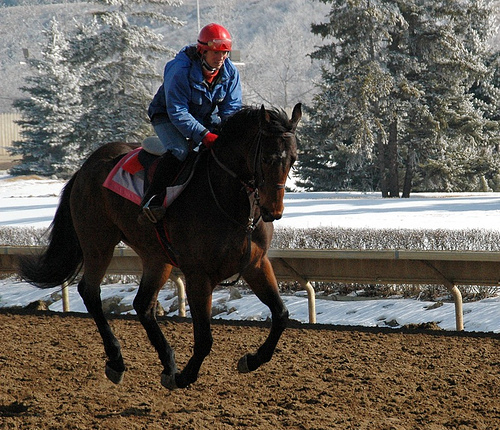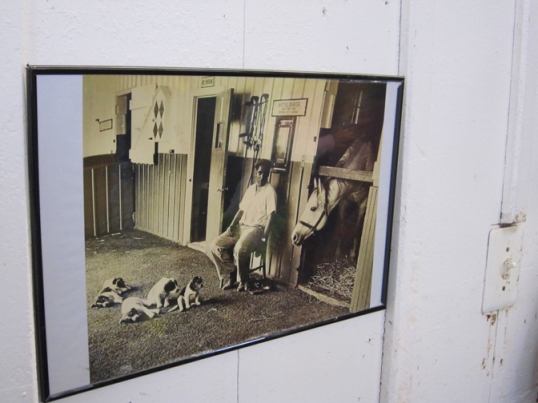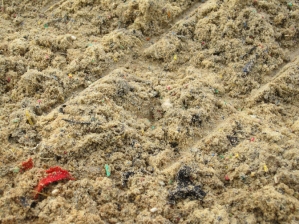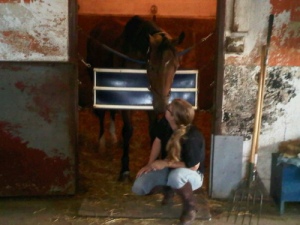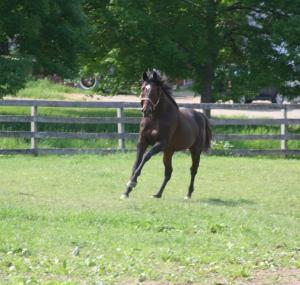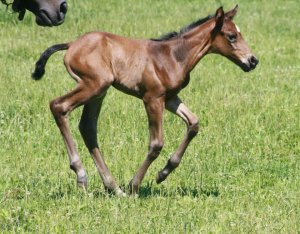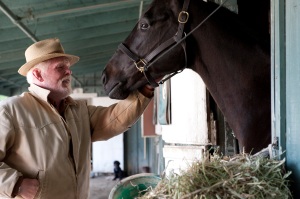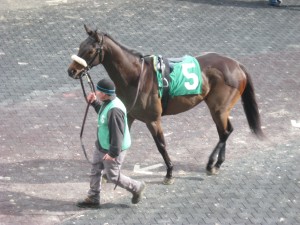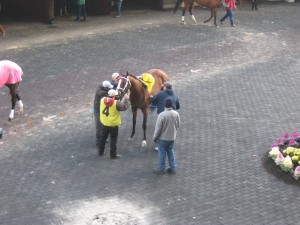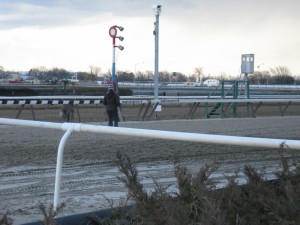This is Sunday Book Review day, but I’m afraid things have to diverge from the usual editorial calendar.
Let’s talk about the New York Times story, shall we?

Above the fold.
If you don’t know what I’m referring to, it’s this: an investigative report from Joe Drape, Walt Bogdanich, Dara L. Miles, and Griffen Palmer, published in today’s edition of the New York Times, entitled Breakdown: Death and Disarray at America’s Racetracks—Mangled Horses, Maimed Jockeys. And it’s just as awful as the name would indicate.
Joe Drape is the most familiar name on the list of contributors for me, anyway; he is the Times’ most active horse-racing correspondent and a fairly regular face on Twitter (@joedrape). But I usually see Drape’s byline on the Sports page: occasional racing stories, or the Triple Crown-season feature The Rail.
This piece isn’t on the Sports page. This is the headliner of today’s New York Times.
I was excited when Neville Bardos made the front page, period.
But this. . . this is something else, altogether.
If you get to the webpage and can’t get past the photo of the abandoned Quarter Horse gelding, Teller A Gone, lying in a Ruidoso, NM, junkyard, I forgive you. It isn’t a terribly graphic picture, to my mind; for one thing, if you’ve been with horses for any length of time, you’ve probably seen them die, and for another, this one could be mid-nap, for the uninitiated (or illiterate). Not to mention the New York Times regularly runs horrifying gory images of humans in various stages of dying, death, or decomposition, and this is, if you’ll pardon the term, “just a horse,” without any bullet holes or gaping wounds or flies buzzing around its dried tears.
But I don’t think readers are going to view it that way, and who can blame them: in America, animals, especially those that the average American would generally think of as a “pet,” are a hands-off area. Don’t mess with our dogs, our cats, or our horses, Americans say, again and again. It’s never “just a horse” to the casual, uninvested reader, and such a phrase could start street fights amongst the horse-owners in the suburbs. In short, this isn’t going to go over well.
If you can get past the photo, read the article first, and then make your own judgements about whether or not you can click on the photo. Because it’s really a link to a five-minute documentary video, and you can fit a lot of breakdowns into five minutes. Horse after horse after horse goes down. There’s no blood, it’s just race replays, the kind you pull up yourself on the Internet. If you wanted to. I wouldn’t.
It’s amazing how much it hurts, how it never gets better. The sick feeling in your stomach when a horse goes down. There is footage of Archarcharch hobbling to the ambulance after the 2011 Kentucky Derby. I tasted coffee in my throat where there should not have been coffee. I wiped a tear away. Seeing horses in agony is a trial you never learn to live with.
There are really great quotes in the video, especially from state vets at Finger Lakes, who are frustrated and saddened by the horses who are entered into races on the verge of falling apart. But then again, there are the breakdowns. So maybe don’t watch the video. You don’t need to. You know. We know. Preach to the choir, but we know.
But maybe other people don’t. Maybe there are people sitting in my favorite cafe right now, reading the Times with their egg and cheese panini and their Stumptown coffee, shaking their head over dead horses and maimed jockeys, over drugged animals and discouraged vets. Maybe the owner is remembering that I am a former exercise rider and an enthusiastic racing fan, and he’s thinking, “Maybe I got that girl wrong, she’s into this crap? Killing horses to make a buck?”
I’ll bet if I go in there tomorrow morning, he’ll ask me about it.
Someone is going to ask you about it.
People are going to be talking.
It’s going to get ugly. Uglier, really, than it has been. Uglier than the PETA videos. Uglier than the cancellation of Luck. We’re heading into Triple Crown season, the only time of year when horse racing makes any sort of media presence known at all, with the truth breathing down our necks. Horses die, with alarming ease and inventiveness, on any given day in any given sport. But lower-level claimers running in the United States of America die far too often.
Is this report good, or bad, for racing?
I don’t believe in sitting on fences. Maybe it’s because I always lined the top board of my fences with electric tape. Whatever the cause, I like to force myself to make a decision, to climb off the damn fence. I won’t sit on the fence on this one, and say, Well, on one hand, it’s important that these issues are raised, but on the other hand, the media is continuing to demonize horse-racing by only showing the bad, and penalizing horsemen by chasing people away from the track, lowering handle, and continuing to lower horse-racing’s esteem in the public eye, and that is simply going to lead to tracks shutting down, people out of work, horses out of work, and valuable research dollars being lost that are funded by horsemen groups and organizations like the Jockey Club, meaning that veterinary medicine will lose ground in its fights against injury and disease.
(That’s not even sitting on the fence, is it? That’s apologizing by way of saying “But look at all the good things racing does do!” Racing does contribute to wonderful things… that is why I am pro-racing, all the time, every day. But I’m also not a fan of sugar-coating things. Some might say, I can’t.)
I’m going to clamber off the fence on the Good side. This is a good article. This is an important, thoughtful, eye-brow-raising article, which examines real problems, concludes that break-downs are linked to drugs, and then talks to invested people on both sides of the drugging debate, and examines the moves that have been made to clear our horses of drugs and the counter-moves that have been made in resistance.
It also pushes the need so many fans and horsemen alike see, for a national governing body for horse racing. State-run racing commissions oversee horse racing, and again and again certain commissions prove that they are not policed, they have no teeth, and they are not willing to go to bat for horses. If there isn’t going to be a national governing body to say “This is how things are going to be done,” then they are going to continue, especially at cheap racetracks like Ruidoso Downs, to offer high, casino-financed purses to horses that are being held together, for the sole purpose of winning those purses that are several times their financial value, with every kind of drug they can get into that horse’s system.
One of the first things I learned about horses and veterinary medicine: if you suspect colic, don’t give your horse Banamine until the vet has seen the horse, because Banamine masks pain.
Apparently, that’s one of the first things some of these trainers learn as well. They just use that information differently than I would have.
And when efforts to help horses and riders by national organizations like the NTRA and the Jockey Club are scorned by racetracks? Thanks for nothing, guys. We know where your heart truly is, and it isn’t in the best interests of the horses. From the Times report:
Race officials have always done their best to hide fatal breakdowns, erecting screens around fallen horses and then refusing to disclose the tracks’ accident rates.
…
Fifty-five tracks pledged that they would seek accreditation, requiring among other things prerace inspections and postmortem examinations, or necropsies. Fewer than half have kept their promise.
“Some tracks do not have the money to spend to meet our standards; others think it’s window dressing and why bother,” said Michael Ziegler, executive director of the National Thoroughbred Racing Association Safety and Integrity Alliance. “Any follow-up with tracks has gone unanswered.”
The safety of horse and rider is going unanswered, but I think it’s safe to say that no one in the racing office is ignoring calls from the casino organizations. Purse money has become the paramount concern of certain racetracks: not attracting new fans, or protecting the lives of the animals and people who go out on the track themselves. Purse money, the great band-aid, keeping bad horsemen in business while the racetrack visitors turn left at the casino entrance and never even consider the horses on the oval out back. Are casinos going to keep racing afloat long enough for industry leaders to fix its problems, or are casinos going to simply hasten its departure?
The New York Times report is damning, yes, but it’s damning of problems that we know must go. The use of drugs in horses. The faulty title of “therapeutic” given to painkillers. These two quotes are especially telling:
Mr. Stirling [chairman of the national medication committee for the Horsemen’s Benevolent and Protective Association] and others say sore horses should not be denied therapeutic medicine when needed. “If you’re a horseman and you’re trying to keep a horse going and keep him happy and healthy as you can, then these therapeutic medications are very helpful,” he said.
…
“Therapeutic drugs, by definition, are used for healing and curing,” said Arthur B. Hancock III, whose farm produced three Kentucky Derby winners. “Drugs that mask pain and enhance performance are not ‘therapeutic.’ They are what they are: performance-enhancing drugs.”
Mr. Stirling is making the case for broke horsemen everywhere, who have to run a horse as often as possible in order to make a buck, or make a living, whatever the case may be. While I know it’s hard to make a living with horses, in whatever business, I disagree categorically with anyone who thinks it’s acceptable to dose a horse with a painkiller and send it out, whether to jump a Grand Prix course or run a race. I side whole-heartedly with Mr. Hancock on this issue.
In the end, of course, you can look at this as just another story taking horse racing out behind the woodshed while other horse sports go on their merry way. I have yet to see a New York Times article on the drugging debate in the hunter show-ring. No one has opined on the trainer who wrote in the Chronicle of the Horse that everyone going into the hunter division should just be allowed to legally tranquilize their horses and save themselves the trouble of finding work-around sedatives that aren’t found in blood-tests yet. I’d say it’s because horses don’t die in the hunter division because of drugging, but of course, that isn’t true. It’s because hunters are not a betting sport, because hunters are not televised, because they do their dying in private, respectably, not out on a public track with the sort of people you wouldn’t let your horse-crazy daughter anywhere near cheering them on.
But racing is the sport that gives all other horse sports their advances in technology and, ironically, safety. Horse racing dollars fuel the veterinary research studies that save premature foals, bring back horses with soft-tissue injuries, rescue horses with previously fatal injuries. Look at Neville Bardos, brought back from the brink of death, a recovery largely credited to hyperbaric oxygen treatments. A therapy that started, where else, with racehorses.
Racing is beautiful, and beneficial, and it can be better. It must be better. So when people ask you about this article, you tell them:
“There are good people and bad people in horse racing. An article like this allows the good to speak out and the bad to be exposed. We’re going to keep fighting to end horse drugging and ban the trainers that run their horses into the ground. Good trainers are able to win without drugging their horses to death. Have you heard of this guy Graham Motion?”
As Horse Racing Business puts it in their summation of the article:
While justifiably railing against the New York Times may make you and me feel better, venting won’t do anything except expend negative energy. People who genuinely care deeply about the sport of horse racing–and the animals and humans involved—need to reform the sport, regardless of whose toes get stepped on in the process. Especially work to rid the sport of race-day medication and the thugs who give racing a bad image. Especially do everything possible to make racing surfaces safer for jockeys and horses. If a racetrack surface temporarily goes bad due to weather, or whatever, cancel the day’s races.
Get angry about images of dead horses and sensational writing if you want. But then admit that it is broken, and work towards fixing it.
Click here for: The New York Times, Mangled Horses and Maimed Jockeys.
Related on this site: Ignoring the Good: A Horsewoman’s Response to the New York Times Expose
Related on this site: Senator Tom Udall (D-NM) Response: “A Disturbing Picture”


